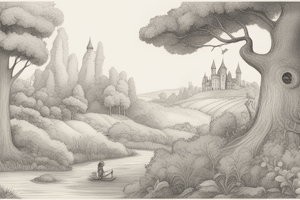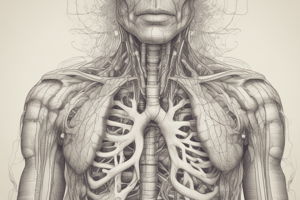Podcast
Questions and Answers
What are the two main groups that the organs of the respiratory system are divided into?
What are the two main groups that the organs of the respiratory system are divided into?
The respiratory system is divided into two main groups: the conducting zone and the respiratory zone.
The respiratory system supplies the body with oxygen and removes carbon dioxide.
The respiratory system supplies the body with oxygen and removes carbon dioxide.
True (A)
What is the primary function of the conducting zone of the respiratory system?
What is the primary function of the conducting zone of the respiratory system?
The primary function of the conducting zone is to carry air to the sites of gas exchange in the lungs.
What is the name of the actual site of gas exchange in the lungs?
What is the name of the actual site of gas exchange in the lungs?
Which of the following are functions of the nose?
Which of the following are functions of the nose?
What is the pharynx?
What is the pharynx?
Match the following parts of the pharynx with their descriptions:
Match the following parts of the pharynx with their descriptions:
What is the function of the pharyngeal tonsil, also known as the tubal tonsil?
What is the function of the pharyngeal tonsil, also known as the tubal tonsil?
What is the function of the larynx?
What is the function of the larynx?
What is the difference between true vocal cords and false vocal cords?
What is the difference between true vocal cords and false vocal cords?
What is the trachea?
What is the trachea?
What is the function of the C-shaped rings of hyaline cartilage in the trachea?
What is the function of the C-shaped rings of hyaline cartilage in the trachea?
What is the bronchial tree?
What is the bronchial tree?
What is the primary function of the respiratory zone of the respiratory system?
What is the primary function of the respiratory zone of the respiratory system?
What is the function of the alveoli?
What is the function of the alveoli?
What is the location of the lungs?
What is the location of the lungs?
What is the hilum of the lung?
What is the hilum of the lung?
The left and right lungs are identical in size.
The left and right lungs are identical in size.
What is the cardiac notch?
What is the cardiac notch?
What is the function of the fissures in the lungs?
What is the function of the fissures in the lungs?
What is the function of the pulmonary arteries?
What is the function of the pulmonary arteries?
What is the function of the bronchial arteries?
What is the function of the bronchial arteries?
Where do the pulmonary vessels and bronchi enter and exit the lungs?
Where do the pulmonary vessels and bronchi enter and exit the lungs?
How are the lungs innervated?
How are the lungs innervated?
What is the pleura?
What is the pleura?
What is the function of the pleural cavity?
What is the function of the pleural cavity?
What are the two phases of pulmonary ventilation?
What are the two phases of pulmonary ventilation?
What are the muscles involved in inspiration?
What are the muscles involved in inspiration?
How does the diaphragm contribute to inspiration?
How does the diaphragm contribute to inspiration?
How do the external intercostal muscles contribute to inspiration?
How do the external intercostal muscles contribute to inspiration?
What is the mechanism of expiration in healthy individuals?
What is the mechanism of expiration in healthy individuals?
Expiration always requires active muscle contraction.
Expiration always requires active muscle contraction.
Flashcards
Pulmonary ventilation
Pulmonary ventilation
The movement of air into and out of the lungs, ensuring continuous replacement of gases in the alveoli.
External respiration
External respiration
Gas exchange between air in alveoli and blood in pulmonary capillaries.
Internal respiration
Internal respiration
Gas exchange between blood in systemic capillaries and tissue cells.
Conducting zone
Conducting zone
Signup and view all the flashcards
Respiratory zone
Respiratory zone
Signup and view all the flashcards
Alveoli
Alveoli
Signup and view all the flashcards
Nasal cavity
Nasal cavity
Signup and view all the flashcards
Olfactory mucosa
Olfactory mucosa
Signup and view all the flashcards
Respiratory mucosa
Respiratory mucosa
Signup and view all the flashcards
Nasal conchae
Nasal conchae
Signup and view all the flashcards
Pharynx
Pharynx
Signup and view all the flashcards
Nasopharynx
Nasopharynx
Signup and view all the flashcards
Oropharynx
Oropharynx
Signup and view all the flashcards
Laryngopharynx
Laryngopharynx
Signup and view all the flashcards
Larynx
Larynx
Signup and view all the flashcards
Thyroid cartilage
Thyroid cartilage
Signup and view all the flashcards
Epiglottis
Epiglottis
Signup and view all the flashcards
Trachea
Trachea
Signup and view all the flashcards
Bronchial tree
Bronchial tree
Signup and view all the flashcards
Bronchi
Bronchi
Signup and view all the flashcards
Pulmonary arteries
Pulmonary arteries
Signup and view all the flashcards
Pulmonary veins
Pulmonary veins
Signup and view all the flashcards
Pleura
Pleura
Signup and view all the flashcards
Inspiration
Inspiration
Signup and view all the flashcards
Study Notes
Respiratory System
- Supplies the body with oxygen and removes carbon dioxide
- Respiration involves two main processes:
- Pulmonary ventilation: Moving air into and out of the lungs
- External respiration: Gas exchange between the lungs and blood
- External respiration occurs in the alveoli of the lungs where oxygen diffuses into the blood and carbon dioxide diffuses out
- Internal respiration is exchange of gases between blood and tissues.
- Transport of respiratory gases is done by blood
- Anatomy of the Respiratory System is divided into two zones:
- Conducting zone: Conduits that carry air to the lungs. This zone filters, warms and humidifies air
- Respiratory zone: Actual sites where gas exchange occurs (e.g., alveoli)
Anatomy of the Respiratory System
- Includes conducting and respiratory zones
- Nasal Cavity: Lined with two types of mucosa, respiratory and olfactory; warms, moistens and filters air
- Pharynx: Funnel-shaped tube connecting the nasal cavity and mouth to the larynx and esophagus - Nasopharynx: Passageway only for air - Oropharynx: Passageway for both air and food - Laryngopharynx: Passageway for both air and food.
- Larynx: Voice box
- Contains nine cartilages, including the thyroid cartilage (Adam's apple) and epiglottis
- Involved in voice production and protecting the lower respiratory tract from food aspiration
- Trachea: Tube leading from the larynx to the lungs
- Supported by C-shaped cartilage rings to prevent collapse
- Branches into two primary bronchi
- Bronchial Tree: System of branching airways within the lungs
- Primary bronchi divide into smaller bronchi and bronchioles
- Bronchioles lead to the alveoli(air sacs)
- Lungs: Paired organs in the thoracic cavity
- Surrounded by pleura (serous membrane)
- Right lung has 3 lobes, left has 2 lobes; each lobe has segments
- Contains alveoli (sites of gas exchange)
Ventilation
- The process of breathing
- Inspiration: Inhaling; muscles contract to increase lung volume and pressure decreases.
- Expiration: Exhaling; muscles relax, lung volume decreases and pressure increases thus air moves out.
- External intercostal muscles contract to raise rib cage, diaphragm contracts to increase the volume of the thoracic cavity and reduces pressure.
- In healthy people, expiration is a passive process.
Studying That Suits You
Use AI to generate personalized quizzes and flashcards to suit your learning preferences.




